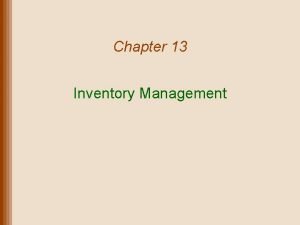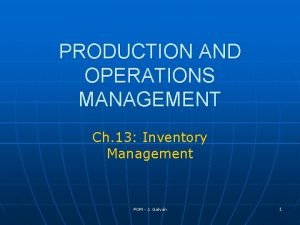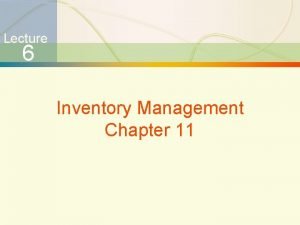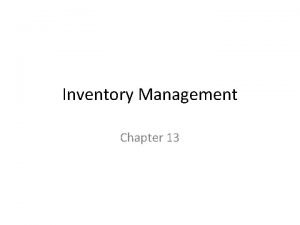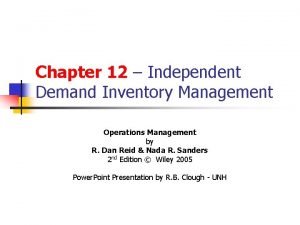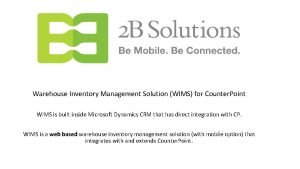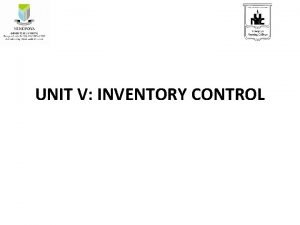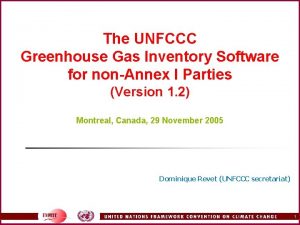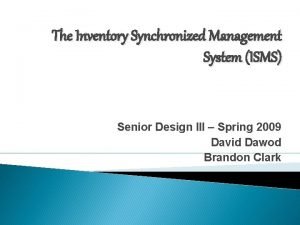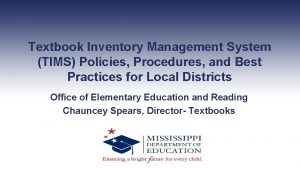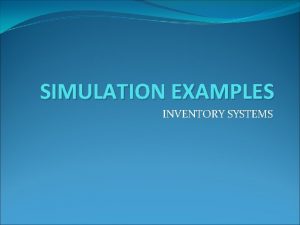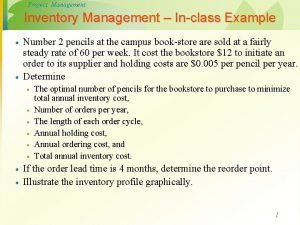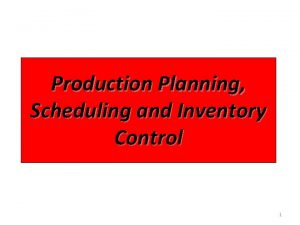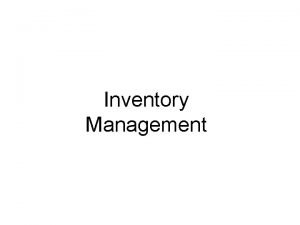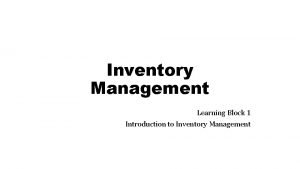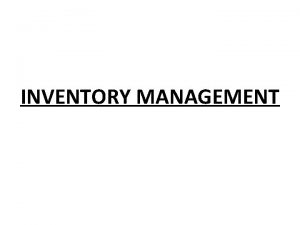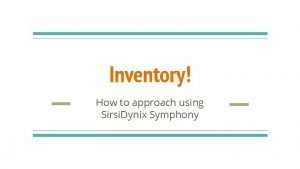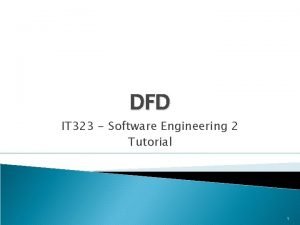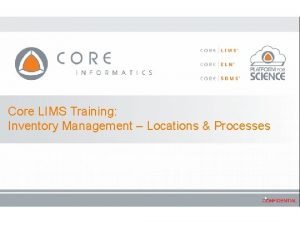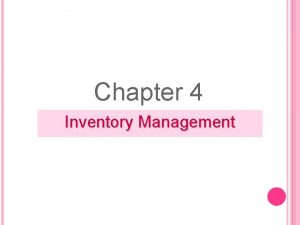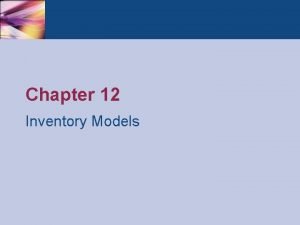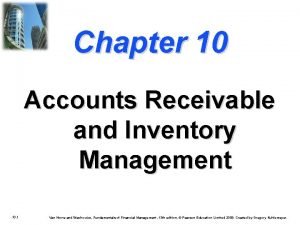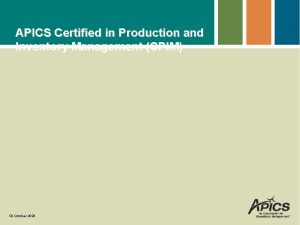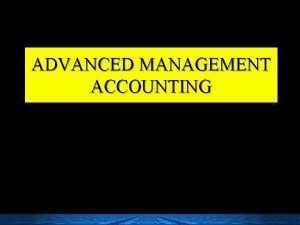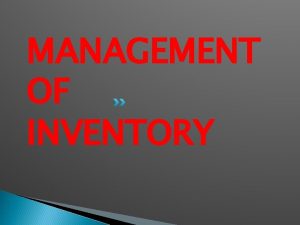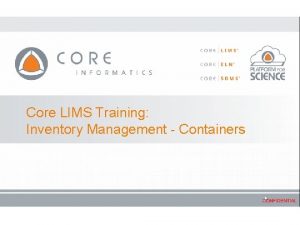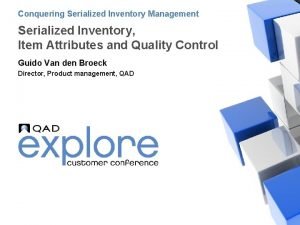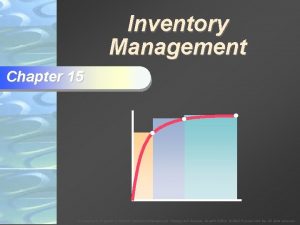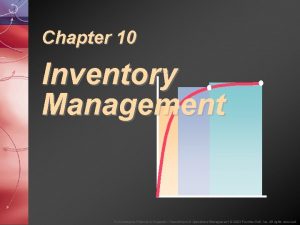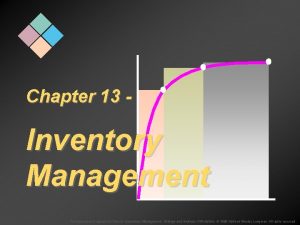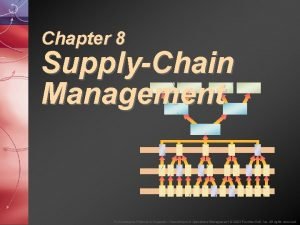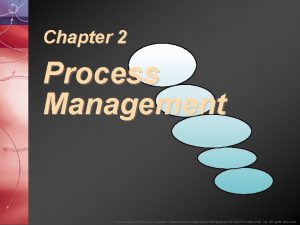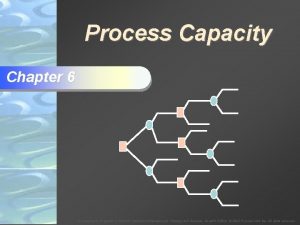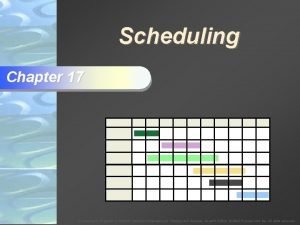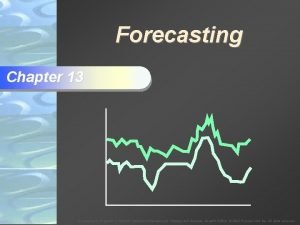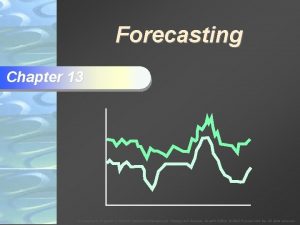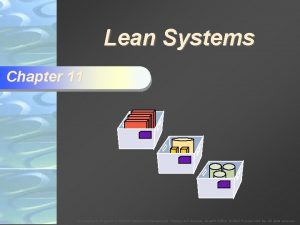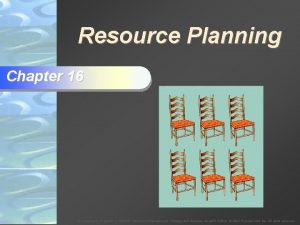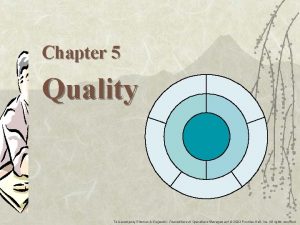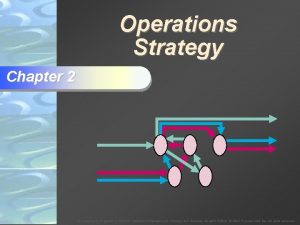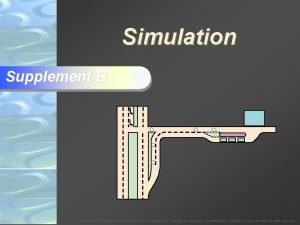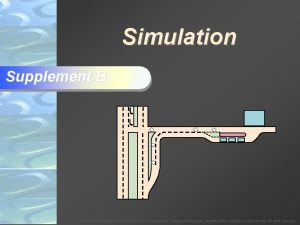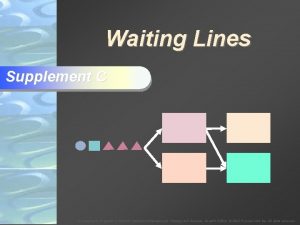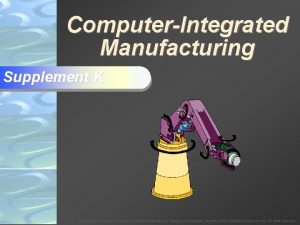Inventory Management Chapter 15 To Accompany Krajewski Ritzman















































- Slides: 47

Inventory Management Chapter 15 To Accompany Krajewski & Ritzman Operations Management: Strategy and Analysis, Seventh Edition © 2004 Prentice Hall, Inc. All rights reserved.

Inventory Costs · Interest or Opportunity Cost · Storage and Handling Costs · Taxes, Insurance, and Shrinkage To Accompany Krajewski & Ritzman Operations Management: Strategy and Analysis, Seventh Edition © 2004 Prentice Hall, Inc. All rights reserved.

Inventory Costs · Customer Service · Ordering Cost · Setup Cost · Labor and Equipment Utilization · Transportation Costs · Payments to Suppliers To Accompany Krajewski & Ritzman Operations Management: Strategy and Analysis, Seventh Edition © 2004 Prentice Hall, Inc. All rights reserved.

Types of Inventory Cycle Inventory Q+0 Average cycle inventory = 2 Safety Stock Inventory Anticipation Inventory Pipeline inventory = DL = d. L To Accompany Krajewski & Ritzman Operations Management: Strategy and Analysis, Seventh Edition © 2004 Prentice Hall, Inc. All rights reserved.

Types of Inventory Cycle inventory = Q/2 = 280/2 = 140 drills Pipeline inventory = = = DL = d. L (70 drills/week)(3 weeks) 210 drills Example 15. 1 To Accompany Krajewski & Ritzman Operations Management: Strategy and Analysis, Seventh Edition © 2004 Prentice Hall, Inc. All rights reserved.

Types of Inventory Tutor Estimating Inventory Levels Figure 15. 1 To Accompany Krajewski & Ritzman Operations Management: Strategy and Analysis, Seventh Edition © 2004 Prentice Hall, Inc. All rights reserved.

ABC Analysis Percentage of dollar value 100 — Class C Class B 90 — Class A 80 — 70 — 60 — 50 — 40 — 30 — 20 — 10 — 0— Figure 15. 2 10 20 30 40 50 60 70 80 90 100 Percentage of items To Accompany Krajewski & Ritzman Operations Management: Strategy and Analysis, Seventh Edition © 2004 Prentice Hall, Inc. All rights reserved.

How Much? When! To Accompany Krajewski & Ritzman Operations Management: Strategy and Analysis, Seventh Edition © 2004 Prentice Hall, Inc. All rights reserved.

Economic Order Quantity To Accompany Krajewski & Ritzman Operations Management: Strategy and Analysis, Seventh Edition © 2004 Prentice Hall, Inc. All rights reserved.

Economic Order Quantity Assumptions 1. Demand rate is constant 2. No constraints on lot size 3. Only relevant costs are holding and ordering/setup 4. Decisions for items are independent from other items 5. No uncertainty in lead time or supply To Accompany Krajewski & Ritzman Operations Management: Strategy and Analysis, Seventh Edition © 2004 Prentice Hall, Inc. All rights reserved.

Economic Order Quantity On-hand inventory (units) Receive order Inventory depletion (demand rate) Q Average cycle inventory Q — 2 Figure 15. 3 1 cycle Time To Accompany Krajewski & Ritzman Operations Management: Strategy and Analysis, Seventh Edition © 2004 Prentice Hall, Inc. All rights reserved.

Economic Order Quantity Annual cost (dollars) Total cost = HC + OC Figure 15. 4 Holding cost (HC) Ordering cost (OC) Lot Size (Q) To Accompany Krajewski & Ritzman Operations Management: Strategy and Analysis, Seventh Edition © 2004 Prentice Hall, Inc. All rights reserved.

Economic Order Quantity Example 15. 2 Annual cost (dollars) 3000 — Total cost = Q D ( H) + ( S) 2 Q 2000 — Holding cost = Q ( H) 2 1000 — Ordering cost = 0— | 50 | 100 | 150 | 200 | 250 | 300 | 350 D ( S) Q | 400 Lot Size (Q) To Accompany Krajewski & Ritzman Operations Management: Strategy and Analysis, Seventh Edition © 2004 Prentice Hall, Inc. All rights reserved.

Economic Order Quantity Example 15. 2 Annual cost (dollars) 3000 — Total cost = 2000 — Q D ( H) + ( S) 2 Q Bird feeder costs D = (18 /week)(52 weeks) = 936 units H = 0. 25 ($60/unit) = $15 S = $45 Q = 390 units Holding cost = Q ( H) 2 1000 — Q D C= (H) + (S) 2 Q | 50 | 100 | 150 Ordering cost = | 200 C 0 — = $2925 + $108 = $3033 | 250 | 300 | 350 D ( S) Q | 400 Lot Size (Q) To Accompany Krajewski & Ritzman Operations Management: Strategy and Analysis, Seventh Edition © 2004 Prentice Hall, Inc. All rights reserved.

Economic Order Quantity Current cost Example 15. 2 Annual cost (dollars) 3000 — Total cost = 2000 — Q D ( H) + ( S) 2 Q Bird feeder costs D = (18 /week)(52 weeks) = 936 units H = 0. 25 ($60/unit) = $15 S = $45 Q = 390 units Holding cost = Q ( H) 2 1000 — Q D C= (H) + (S) 2 Q | 50 | 100 | 150 Ordering cost = | 200 C 0 — = $2925 + $108 = $3033 | 250 Lot Size (Q) | 300 | 350 D ( S) Q | 400 Current Q To Accompany Krajewski & Ritzman Operations Management: Strategy and Analysis, Seventh Edition © 2004 Prentice Hall, Inc. All rights reserved.

Economic Order Quantity Current cost Example 15. 2 Annual cost (dollars) 3000 — Total cost = 2000 — Q D ( H) + ( S) 2 Q Bird feeder costs D = (18 /week)(52 weeks) = 936 units H = 0. 25 ($60/unit) = $15 S = $45 Q = 390 units Holding cost = Q ( H) 2 1000 — Q D C= (H) + (S) 2 Q | 50 | 100 | 150 Ordering cost = | 200 C 0 — = $2925 + $108 = $3033 | 250 Lot Size (Q) | 300 | 350 D ( S) Q | 400 Current Q To Accompany Krajewski & Ritzman Operations Management: Strategy and Analysis, Seventh Edition © 2004 Prentice Hall, Inc. All rights reserved.

Economic Order Quantity Current cost Example 15. 2 Annual cost (dollars) 3000 — Total cost = 2000 — Q D ( H) + ( S) 2 Q Bird feeder costs D = (18 /week)(52 weeks) = 936 units H = 0. 25 ($60/unit) = $15 S = $45 Q = 468 units Holding cost = Q ( H) 2 1000 — Q D C= (H) + (S) 2 Q | 50 | 100 | 150 Ordering cost = | 200 C 0 — = $3510 + $90 = $3600 | 250 Lot Size (Q) | 300 | 350 D ( S) Q | 400 Current Q To Accompany Krajewski & Ritzman Operations Management: Strategy and Analysis, Seventh Edition © 2004 Prentice Hall, Inc. All rights reserved.

Economic Order Quantity Current cost Example 15. 2 Annual cost (dollars) 3000 — Bird feeder costs Q D Total cost = D(H )(18 + /week)(52 ( S) = weeks) = 936 units 2 Q H = 0. 25 ($60/unit) = $15 S = $45 Q = EOQ 2000 — EOQ = Q Holding cost = Q D(H) 2 DS 2 C= (H) + (S) 2 H Q 1000 — Ordering cost = 0— Example 15. 3 | 50 | 100 | 150 | 200 | 250 Lot Size (Q) | 300 | 350 D ( S) Q | 400 Current Q To Accompany Krajewski & Ritzman Operations Management: Strategy and Analysis, Seventh Edition © 2004 Prentice Hall, Inc. All rights reserved.

Economic Order Quantity Current cost Example 15. 2 Annual cost (dollars) 3000 — Bird feeder costs Q D Total cost = D(H )(18 + /week)(52 ( S) = weeks) = 936 units 2 Q H = 0. 25 ($60/unit) = $15 S = $45 Q = 75 2000 — EOQ = Q Holding cost = Q D(H) 2 DS 2 C= (H) + (S) 2 H Q 1000 — Ordering cost = 0— Example 15. 3 | 50 | 100 | 150 | 200 | 250 Lot Size (Q) | 300 | 350 D ( S) Q | 400 Current Q To Accompany Krajewski & Ritzman Operations Management: Strategy and Analysis, Seventh Edition © 2004 Prentice Hall, Inc. All rights reserved.

Economic Order Quantity Current cost Example 15. 2 Annual cost (dollars) 3000 — Bird feeder costs Q D Total cost = D(H )(18 + /week)(52 ( S) = weeks) = 936 units 2 Q H = 0. 25 ($60/unit) = $15 S = $45 Q = 75 2000 — EOQ = 1000 — Q Holding cost = Q D(H) 2 DS 2 C= (H) + (S) 2 H Q C = $562 + $562 = $1124 Ordering cost = 0— Example 15. 3 | 50 | 100 | 150 | 200 | 250 Lot Size (Q) | 300 | 350 D ( S) Q | 400 Current Q To Accompany Krajewski & Ritzman Operations Management: Strategy and Analysis, Seventh Edition © 2004 Prentice Hall, Inc. All rights reserved.

Economic Order Quantity Current cost Example 15. 2 Annual cost (dollars) 3000 — Bird feeder costs Q D Total cost = D(H )(18 + /week)(52 ( S) = weeks) = 936 units 2 Q H = 0. 25 ($60/unit) = $15 S = $45 Q = 75 2000 — EOQ = 1000 — Q Holding cost = Q D(H) 2 DS 2 C= (H) + (S) 2 H Q C = $562 + $562 = $1124 Ordering cost = Lowest cost 0— Example 15. 3 | 50 | 100 | 150 | 200 | 250 | 300 | 350 | 400 D ( S) Q Current Best Q Lot Size (Q) Q (EOQ) To Accompany Krajewski & Ritzman Operations Management: Strategy and Analysis, Seventh Edition © 2004 Prentice Hall, Inc. All rights reserved.

Economic Order Quantity Current cost Example 15. 2 Annual cost (dollars) 3000 — Bird feeder costs Q D Total cost = D(H )(18 + /week)(52 ( S) = weeks) = 936 units 2 Q H = 0. 25 ($60/unit) = $15 S = $45 Q = 75 2000 — EOQ = 1000 — Q Holding cost = Q D(H) 2 DS 2 C= (H) + (S) 2 H Q C = $562 + $562 = $1124 Ordering cost = Lowest cost 0— Example 15. 3 | 50 | 100 | 150 | 200 | 250 | 300 | 350 | 400 D ( S) Q Current Best Q Lot Size (Q) Q (EOQ) To Accompany Krajewski & Ritzman Operations Management: Strategy and Analysis, Seventh Edition © 2004 Prentice Hall, Inc. All rights reserved.

Economic Order Quantity Current cost Example 15. 2 Annual cost (dollars) 3000 — Bird feeder costs Q D Total cost = D(H )(18 + /week)(52 ( S) = weeks) = 936 units 2 Q H = 0. 25 ($60/unit) = $15 S = $45 Q = 75 2000 — EOQ = 1000 — Q Holding cost = Q D(H) 2 DS 2 C= (H) + (S) Q C = $562 + $562 = $1124 Ordering cost = Lowest cost 0— Figure 15. 6 2 H | 50 | 100 | 150 | 200 | 250 | 300 | 350 | 400 D ( S) Q Current Best Q Lot Size (Q) Q (EOQ) To Accompany Krajewski & Ritzman Operations Management: Strategy and Analysis, Seventh Edition © 2004 Prentice Hall, Inc. All rights reserved.

Economic Order Quantity Current cost Example 15. 2 Annual cost (dollars) 3000 — 2000 — Bird feeder costs Time between orders Q D Total cost = D(H + /week)(52 ( S) = )(18 weeks) = 936 units 2 Q EOQ = $15 HTBO = 0. 25 ($60/unit) = = 75/936 = 0. 080 year EOQ D S = $45 Q = 75 Q Holding cost = Q D(H) 2 DS TBO = (75/936)(12) = 0. 96 months 2 C= (H) + (S) EOQ =EOQ 2 Q H TBOEOQ = (75/936)(52) = 4. 17 weeks C = $562 + $562 = $1124 D days TBOEOQ = (75/936)(365) = 29. 25 Ordering cost = ( S) 1000 — Lowest cost Q 0— Example 15. 3 | 50 | 100 | 150 | 200 | 250 | 300 | 350 | 400 Current Best Q Lot Size (Q) Q (EOQ) To Accompany Krajewski & Ritzman Operations Management: Strategy and Analysis, Seventh Edition © 2004 Prentice Hall, Inc. All rights reserved.

How Much? When! To Accompany Krajewski & Ritzman Operations Management: Strategy and Analysis, Seventh Edition © 2004 Prentice Hall, Inc. All rights reserved.

IP On-hand inventory IP Order received OH OH IP Q Q Soup up So Soup Continuous Review Q OH R Order placed L TBO Time Figure 15. 7 To Accompany Krajewski & Ritzman Operations Management: Strategy and Analysis, Seventh Edition © 2004 Prentice Hall, Inc. All rights reserved.

IP On-hand inventory IP Order received Q Soup up So Soup Continuous Review Chicken Soup Q R = Average demand during lead time OH = (25)(4) = 100 OH cases OH R IP = OH + SR – BO Order = 10 + 200 – 0 = 210 cases placed Order placed L TBO Time Example 15. 4 To Accompany Krajewski & Ritzman Operations Management: Strategy and Analysis, Seventh Edition © 2004 Prentice Hall, Inc. All rights reserved.

Uncertain Demand Figure 15. 8 On-hand inventory IP Order received Q Q Q OH R L 1 TBO 1 Order placed L 2 TBO 2 L 3 Time TBO 3 To Accompany Krajewski & Ritzman Operations Management: Strategy and Analysis, Seventh Edition © 2004 Prentice Hall, Inc. All rights reserved.

Reorder Point / Safety Stock Cycle-service level = 85% Probability of stockout (1. 0 – 0. 85 = 0. 15) Average demand during lead time R z L Figure 15. 9 To Accompany Krajewski & Ritzman Operations Management: Strategy and Analysis, Seventh Edition © 2004 Prentice Hall, Inc. All rights reserved.

Reorder Point / Safety Stock/R Safety stock = z L = 2. 33(22) = 51. 3 = 51 boxes Cycle-service level = 85% Reorder point = ADDLT + SS = 250 + 51 = 301 boxes Probability of stockout (1. 0 – 0. 85 = 0. 15) Average demand during lead time R z L Example 15. 5 To Accompany Krajewski & Ritzman Operations Management: Strategy and Analysis, Seventh Edition © 2004 Prentice Hall, Inc. All rights reserved.

Lead Time Distributions t = 15 t = 26 + 75 Demand for week 1 t = 15 + 75 Demand for week 2 Figure 15. 10 t = 15 225 Demand for three-week lead time = 75 Demand for week 3 To Accompany Krajewski & Ritzman Operations Management: Strategy and Analysis, Seventh Edition © 2004 Prentice Hall, Inc. All rights reserved.

Lead Time Distributions t = 15 + 75 Demand for week 1 t = 26 Bird feeder Lead Time Distribution t = 1 week t = 15 + s. L = st 75 Safety Demand for week 2 d = 18 L =5 stock = z L = t = 15 2 L=2 = 7. 1 225 for 9 units 1. 28(7. 1)Demand = 9. 1 or three-week lead time Reorder point = d. L + Safety stock = 2(18) + 9 = 45 units Example 15. 6 = 75 Demand for week 3 To Accompany Krajewski & Ritzman Operations Management: Strategy and Analysis, Seventh Edition © 2004 Prentice Hall, Inc. All rights reserved.

Lead Time Distributions t = 15 + 75 Demand for week 1 t = 26 Bird feeder Lead Time Distribution t = 1 week t = 15 d = 18 L=2 Reorder point = 2(18) + 9 = 45 units + 225 75 936 C= ($15) + ($45) + 9($15) Demand for 75 2 75 three-week lead time Demand for week 2 t = 15 C = $562. 50 + $561. 60 + $135 = $1259. 10 Example 15. 6 = 75 Demand for week 3 To Accompany Krajewski & Ritzman Operations Management: Strategy and Analysis, Seventh Edition © 2004 Prentice Hall, Inc. All rights reserved.

Lead Time Distributions TABLE 15. 1 PROBABILITY DISTRIBUTION FOR LEAD TIME Lead Time (weeks) Probability for Lead Time 1 2 3 4 5 0. 35 0. 45 0. 10 0. 05 TABLE 15. 2 PROBABILITY DISTRIBUTION FOR DEMAND Demand (units per week) Probability of Demand 10 13 18 23 26 0. 10 0. 20 0. 40 0. 20 0. 10 To Accompany Krajewski & Ritzman Operations Management: Strategy and Analysis, Seventh Edition © 2004 Prentice Hall, Inc. All rights reserved.

Lead Time Distributions t = 15 t = 26 + 75 Demand for week 1 t = 15 + 75 Demand for week 2 t = 15 225 Demand for three-week lead time = Figure 15. 11(a) 75 Demand for week 3 To Accompany Krajewski & Ritzman Operations Management: Strategy and Analysis, Seventh Edition © 2004 Prentice Hall, Inc. All rights reserved.

Lead Time Distributions t = 15 t = 26 + 75 Demand for week 1 t = 15 + 75 Demand for week 2 t = 15 225 Demand for three-week lead time = Figure 15. 11(b) 75 Demand for week 3 To Accompany Krajewski & Ritzman Operations Management: Strategy and Analysis, Seventh Edition © 2004 Prentice Hall, Inc. All rights reserved.

Lead Time Distributions t = 15 t = 26 + 75 Demand for week 1 t = 15 + 75 Demand for week 2 t = 15 225 Demand for three-week lead time = Figure 15. 11(c) 75 Demand for week 3 To Accompany Krajewski & Ritzman Operations Management: Strategy and Analysis, Seventh Edition © 2004 Prentice Hall, Inc. All rights reserved.

Lead Time Distributions t = 15 t = 26 + 75 Demand for week 1 t = 15 + 75 Demand for week 2 t = 15 225 Demand for three-week lead time = Figure 15. 11(d) 75 Demand for week 3 To Accompany Krajewski & Ritzman Operations Management: Strategy and Analysis, Seventh Edition © 2004 Prentice Hall, Inc. All rights reserved.

Periodic Review Systems On-hand inventory T IP IP Order received Q 1 OH Order received OH Q 2 IP Q 3 Order received IP 1 IP 3 IP 2 Order placed L L P Figure 15. 12 L P Time Protection interval To Accompany Krajewski & Ritzman Operations Management: Strategy and Analysis, Seventh Edition © 2004 Prentice Hall, Inc. All rights reserved.

Periodic Review Systems On-hand inventory T IP IP Order received Q 1 OH Q 2 IP 1 IP 3 IP 2 Order received IP = OH + SR – BO Q 3 Q t = T - IPt OH T = 400 OH = 0 BO = 5 SR = 0 Order placed IP = 0 + 0 – 5 = – 5 sets Q = 400 – (– 5) = 405 sets L L P Example 15. 7 TV Set - P System IP L P Time Protection interval To Accompany Krajewski & Ritzman Operations Management: Strategy and Analysis, Seventh Edition © 2004 Prentice Hall, Inc. All rights reserved.

Periodic Review Systems On-hand inventory T IP 1 IP IP IP Order Bird feeder— Calculating P and T received Q 3 = 90% t = cycle/service level Q 118 units L = 2 weeks OH OH Q 2 EOQ = 75 units D = (18 units/week)(52 weeks) = 936 units EOQ 75 P= (52) = 4. 2 or 4 weeks D 936 Order placed P+L = t P + L = 5 placed 6 = 12 units IP 3 IP 2 T = Average demand during the protection interval + Safety stock = d (P + L) + z P + L L = (18 units/week)(16 weeks) + 1. 28(12 units) = 123 units Time P P Example 15. 8 Protection interval To Accompany Krajewski & Ritzman Operations Management: Strategy and Analysis, Seventh Edition © 2004 Prentice Hall, Inc. All rights reserved.

Periodic Review Systems On-hand inventory T IP 1 IP IP Order Bird feeder— Calculating P and T received Q 3 = 90% t = cycle/service level Q 118 units L = 2 weeks OH OH Q 2 EOQ = 75 units D = (18 units/week)(52 weeks) = 936 units IP 3 IP 2 IP P = 4 weeks Order placed C= L Order 936 placed 4(18) ($15) + ($45) + 15($15) 2 4(18) C = $540 + $585 + $225 = $1350 L P Example 15. 8 T = 123 units P L Time Protection interval To Accompany Krajewski & Ritzman Operations Management: Strategy and Analysis, Seventh Edition © 2004 Prentice Hall, Inc. All rights reserved.

Periodic Review Systems On-hand inventory T IP IP Order received Q 1 OH Order received OH Q 2 IP Q 3 Order received IP 1 IP 3 IP 2 Order placed L L P Figure 15. 13 L P Time Protection interval To Accompany Krajewski & Ritzman Operations Management: Strategy and Analysis, Seventh Edition © 2004 Prentice Hall, Inc. All rights reserved.

Periodic Review Systems On-hand inventory T IP IP Order received Q 1 OH Order received OH Q 2 IP Q 3 Order received IP 1 IP 3 IP 2 Order placed L L P Figure 15. 13 L P Time Protection interval To Accompany Krajewski & Ritzman Operations Management: Strategy and Analysis, Seventh Edition © 2004 Prentice Hall, Inc. All rights reserved.

Comparison of Q and P Systems · Convenient to administer · Orders may be combined · IP only required at review Q Systems · Individual review frequencies · Possible quantity discounts · Lower, less-expensive safety stocks To Accompany Krajewski & Ritzman Operations Management: Strategy and Analysis, Seventh Edition © 2004 Prentice Hall, Inc. All rights reserved.

ABC Analysis – Solved Problem 2 Figure 15. 14 To Accompany Krajewski & Ritzman Operations Management: Strategy and Analysis, Seventh Edition © 2004 Prentice Hall, Inc. All rights reserved.

Comparison of P and Q Systems – Solved Problem 6 Figure 15. 15 To Accompany Krajewski & Ritzman Operations Management: Strategy and Analysis, Seventh Edition © 2004 Prentice Hall, Inc. All rights reserved.
 Slide to doc.com
Slide to doc.com Accompany chapter 1
Accompany chapter 1 Prof. mirosław krajewski
Prof. mirosław krajewski Profesor wojciech krajewski
Profesor wojciech krajewski Andy krajewski
Andy krajewski Things that belong to salvation
Things that belong to salvation Dorsal venous arch
Dorsal venous arch Inkjet printers are considered legacy technology
Inkjet printers are considered legacy technology Operations management chapter 12 inventory management
Operations management chapter 12 inventory management Chapter 13 inventory management problems and solutions
Chapter 13 inventory management problems and solutions Chapter 13 inventory management
Chapter 13 inventory management Chapter 13 inventory management
Chapter 13 inventory management Chapter 13 inventory management
Chapter 13 inventory management Chapter 13 inventory management
Chapter 13 inventory management Independent demand item
Independent demand item Warehouse inventory management solution (wims) nulled
Warehouse inventory management solution (wims) nulled Inventory meaning
Inventory meaning Greenhouse inventory software
Greenhouse inventory software Conclusion of inventory management
Conclusion of inventory management Textbook management system
Textbook management system Inventory simulation excel
Inventory simulation excel Inventory system project proposal
Inventory system project proposal Gantt chart inventory system
Gantt chart inventory system Production planning inventory control
Production planning inventory control Mapics inventory management
Mapics inventory management Objectives of inventory management
Objectives of inventory management Introduction of inventory
Introduction of inventory Fsn meaning in inventory management
Fsn meaning in inventory management Dependent vs independent demand
Dependent vs independent demand Independent demand inventory examples
Independent demand inventory examples Introduction of inventory management
Introduction of inventory management 6 functions of inventory
6 functions of inventory Symphony inventory management
Symphony inventory management Dfd it
Dfd it Lims inventory management
Lims inventory management Cherwell configuration management
Cherwell configuration management Stockpile inventory management
Stockpile inventory management Typically inventory model address
Typically inventory model address Receivable and inventory management
Receivable and inventory management Cayenta erp
Cayenta erp Certified in production and inventory management
Certified in production and inventory management The theory of constraints
The theory of constraints Define the term inventory management
Define the term inventory management Ebo ibm
Ebo ibm What is inventry management
What is inventry management Independent demand system
Independent demand system Inventory management for pails
Inventory management for pails Serialized item management
Serialized item management









